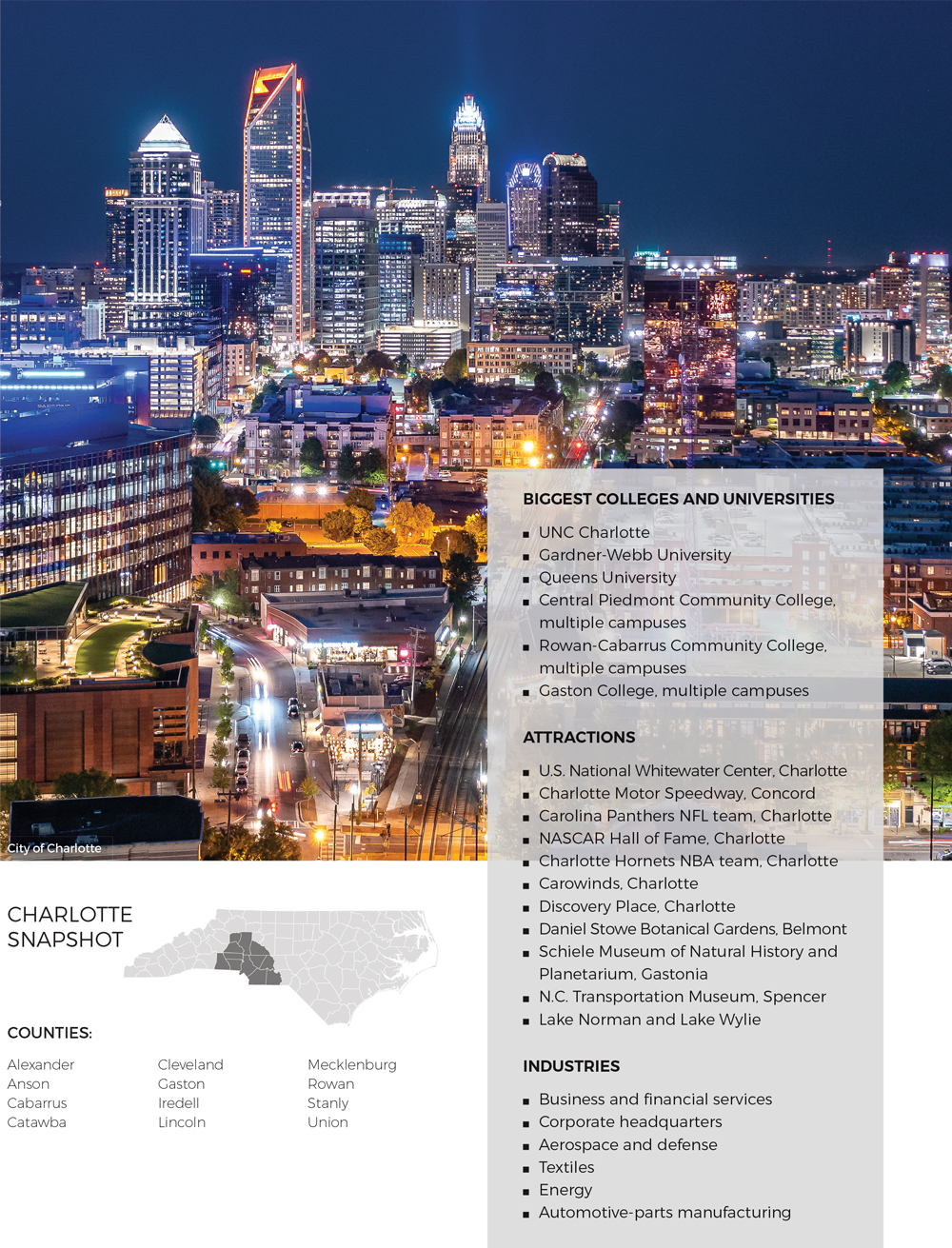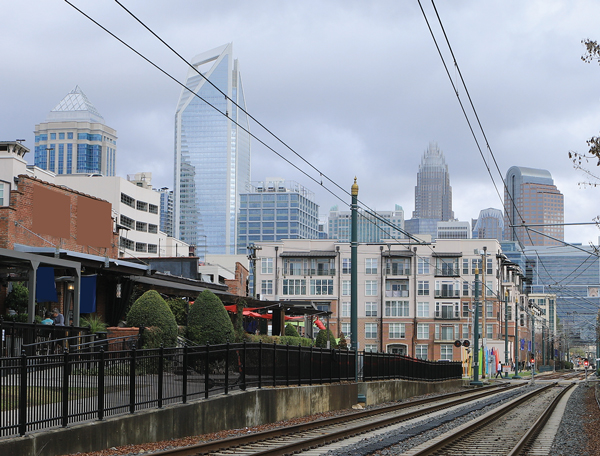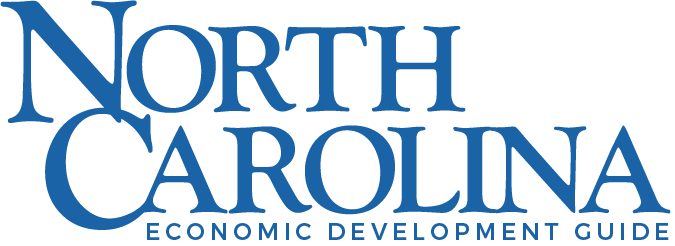Focus: Charlotte region, ready to work
Companies of all stripes choose the 12-county Charlotte region for many reasons. But workforce is one of the most important. An array of customized educational opportunities continuously improves and replenishes its pool of skilled workers, who enjoy an unmatched quality of life.
—By Katherine Snow Smith
Arrival has big plans in the Charlotte region. The United Kingdom-based electric vehicle maker is building a $41 million factory at Meadow Oak Commerce Center in west Charlotte, not far from Charlotte Douglas International Airport. The delivery vans it will produce go about 150 miles between charges. Shipping and logistics provider UPS is buying 10,000 of them. And electric buses will be produced at its $46 million factory in Rock Hill, about 35 miles away in South Carolina. Both are expected to be up and running this year.
But these aren’t your typical assembly plants. Small in stature, Arrival’s “microfactories” source materials, build parts and sell their finished products locally. This reduces their environmental impact and makes them easily scalable — as many as 10,000 delivery vans or 1,000 buses annually with two shifts of workers — keeping pace with the surrounding region’s demand, the company claims.
Anthony Burton, principal researcher at Charlotte Regional Business Alliance, finds Arrival’s manufacturing model fascinating. “If they can’t find materials, they are going to make them,” he says. “They are having a vertical approach to the hardware and the software and the smart technology.” He expects businesses with similar goals and processes to follow, discovering how well the Charlotte region aligns with advanced manufacturing.
Arrival plans to hire 150 people for its $3 million North American headquarters in South End, the thriving business and residential district near Uptown Charlotte. It’ll be in good company. Charotte Regional Business Alliance says nine of the largest publicly traded companies and 18 of the 1,000 largest have headquarters within the 11 North Carolina and four South Carolina counties that it represents. They include financial giant Bank of America, home improvement retailer Lowe’s and Nucor, which makes steel and steel products. St. Louis-based managed-care provider Centene recently announced the first phase of its East Coast headquarters — 800,000 square feet of meeting and office space — in Charlotte. It’s expected to be complete this year. The second phase is expected to begin in 2024. It’ll push the campus to 2.4 million square feet and the employee headcount to 6,000.
Arrival CEO Mike Ableson says his company is a technology company at its heart. Many of the 250 workers at each microfactory will be engineers, writing and developing the software used to create parts and assemble vehicles. “We chose Charlotte as our U.S. headquarters for many reasons, including its East Coast location; a diverse, high-skilled workforce; government and corporate partners willing to partner on shared goals for future sustainability and equity; and the airport,” he says. “We look forward to growing in the Carolinas as we accelerate the transition to zero emissions vehicles.”
As recently as two decades ago, the right site, low costs and a business-friendly community were the top reasons businesses cited for locating or expanding in the Charlotte region. While a talented workforce has always been important, it’s climbing that list. “Talent was in the top 10 or 15 in terms of a decision factor and what a company would want to know more about,” says Janet LaBar, Charlotte Regional Business Alliance president and CEO. “I think [a talented workforce] has been accelerated easily into the top three over the years. It’s about the first thing [businesses] ask about.”
A highly skilled workforce and the ability to train more people were key in landing Arrival. “This is kind of a dream project,” LaBar says. “Arrival sees the manufacturing strengths we have here that are very mature and established in the region.”

MUTUAL ATTRACTION
Catharine Pappas knows firsthand why companies choose the Charlotte region. She’s director of relocation and client services at Charlotte-based Dickens Mitchener Residential Real Estate, which has more than 115 agents, most of whom assist in relocations. Some are working to find homes for Arrival employees. “North Carolina is a huge draw because of our low corporate tax rate,” she says. “Charlotte checks all the boxes. We have local talent on the ground. We have amazing universities. UNC Charlotte has one of the top business schools in North Carolina. Central Piedmont Community College is one of the best community colleges around.”
Pappas says there’s plenty more to attract businesses. “Our airport is amazing,” she says. “Most companies can get to 90% of their clients within two hours from Charlotte. The less time your workforce is in the air the better. We have clients who live in Charlotte and commute to New York every week because it’s so easy and much less expensive than living there.”

Belmont is home to the 380-acre Daniel Stowe Botanical Garden, a destination for spectacular gardens, sparkling fountains, a conservatory, a garden store and nature trails.
While numbers have fluctuated during the COVID-19 pandemic, Charlotte Douglas International Airport averages 700 flights a day and offers nonstop service to 145 cities, including 33 international destinations, according to the Charlotte Regional Business Alliance. Pappas helped relocate employees from a company moving to Charlotte from Austin, Texas, a couple years ago. She says the main reason they left was that visiting a client meant two days dedicated to travel.
Employees of these companies are happy to relocate to the Charlotte region, too. Pappas says they account for about 25% of closings at Dickens Mitchener each year. “They love the quality of life,” she says. “They love our weather. Charlotte has national sports teams and over 56 miles of developed greenway trails. You can find live music most nights of the week. The U.S. National Whitewater Center offers year-round recreational activities. All of these things make Charlotte hot on everybody’s list.”
The pandemic magnified the importance of loving where you live. “Clients want their home to be their sanctuary,” Pappas says. “It’s not just an investment or a place to sleep. People are ready for the quality of life we have here. They want a yard. They want a place to entertain.”
Wherever a company relocates or expands in the Charlotte region, its employees have housing options. Charlotte, for example, offers stately homes shaded by large oaks, craftsman bungalows on brick streets, and downtown condominiums and apartments. Seven in 10 people moving to the Charlotte region ended up in Mecklenburg County in 2011. But by 2019, it was the destination of only three in 10. Wide-open spaces, new housing developments and small-town living is less than an hour away in any direction of Uptown. That includes Belmont in Gaston County. “Belmont has an adorable, quaint downtown,” Pappas says. “It’s about a 15- to 20-minute commute to Uptown Charlotte on Interstate 85.”
Many commuters drive to Charlotte for work. But within the next decade, plans call for more of them to have the option of traveling by light rail. Charlotte Area Transit System has proposed adding the 29-mile Silver Line to its LYNX light-rail system under its 2030 plan. It would run from Belmont through Charlotte’s center to Matthews in Union County. Its 29 stops would include the airport, Truist Ballpark, home to Triple A baseball team Charlotte Knights, Bank of America Stadium, home to the NFL’s Carolina Panthers, community college campuses and hospitals.

Charlotte’s light rail line
CATS currently operates two rail lines. Its 4-mile CityLYNX Gold Line offers streetcar service to 17 stops from the historic West End through Center City to the Elizabeth Neighborhood. Its service length and number of stops will more than double under the 2030 plan. “The Gold Line that goes through Uptown to Johnson C. Smith [University] has really opened up Biddleville [neighborhood],” Pappas says. “There’s charming craftsman style housing as well as some new construction.”
The nearly 19-mile LYNX Blue Line connects South Boulevard at Interstate 485 and UNC Charlotte’s main campus. It’s about a 45-minute ride from end to end and has 26 stations and 11 park-and-ride locations. CATS also has proposed a Red Line as part of its 2030 plan. It would connect northern suburbs, including Davidson, Huntersville and Cornelius, with Charlotte.
The LYNX system’s Blue Line stops in South End, where Arrival’s headquarters will open. LaBar says Charlotte’s light rail was a big draw for the company. The neighborhood is exploding with new housing and businesses. From an eBike store to numerous restaurants and loft apartments to hip nightlife, it’s attracting thousands of new patrons and residents from ages 18 to 30.

The U.S. National Whitewater Center
TRAINING TOMORROW’S WORKERS
Manufacturers aren’t the only ones hiring workers with tech skills. Centene’s North Carolina operations, for example, have hired about 900 employees. About 60% of them are in Charlotte, according to a Centene spokesperson. They have a breadth of duties, including information technology and business analytics. And commercial banking, which Charlotte Regional Business Alliance says accounted for about 42,000 jobs with an average salary of $156,000 in 2020, has been developing technology before many other business sectors. “Over the past 10 years, they really have ramped up the amount of tech talent they are hiring,” Burton says. “Several tech centers have located in Charlotte over the past few years. Since financial institutions were really ramping up their tech talent, and there was a critical mass and [other tech companies] wanted to take advantage of that.”
While the talent and potential of the Charlotte region’s workforce is an important consideration today, employers know their workforce needs will be different tomorrow. The Charlotte region is ready to meet those, too. “When it comes to being able to prove what our skilled and educated workforce looks like, we have so much to offer because of the saturation of higher education institutions,” LaBar says. Twenty-five research universities are within 200 miles of Charlotte. Schools within the region produce 15,000 graduates a year.
North Carolina is known for its strong system of community colleges, which work closely with industry to customize workforce training programs that teach in-demand skills. Burton pointed to Catawba Valley Community College in Hickory. Its 84,000-square-foot Workforce Solutions Complex, for example, has classrooms and labs where students learn advanced manufacturing and tech skills that are needed in today’s workplace.

A Catawba Valley Community College student tufts a piece of furniture.
Apprenticeships are a time-tested means of workforce training. At Gaston College, for example, Apprenticeship 321 brings together local employers and students, who receive job-specific training while working alongside mentors without paying tuition and earning a paycheck. Registered with ApprencticeshipNC and U.S. Department of Labor, the program also offers graduates nationally recognized
certifications, college credits and a National Career Readiness Certificate.
The Charlotte region’s educational profile got a big boost when Atrium Health, Wake Forest Baptist Health and Wake Forest School of Medicine announced they were creating a four-year medical school, Charlotte’s first. Construction at the 20-acre site, less than 1 mile from Atrium’s Carolina Medical Center, is expected to begin early this year. “We have a great blend of both institutions and programs that are getting folks skilled in a variety of disciplines,” LaBar says. “We are also well positioned to import talent as well. People always want to migrate to the Charlotte region.”

